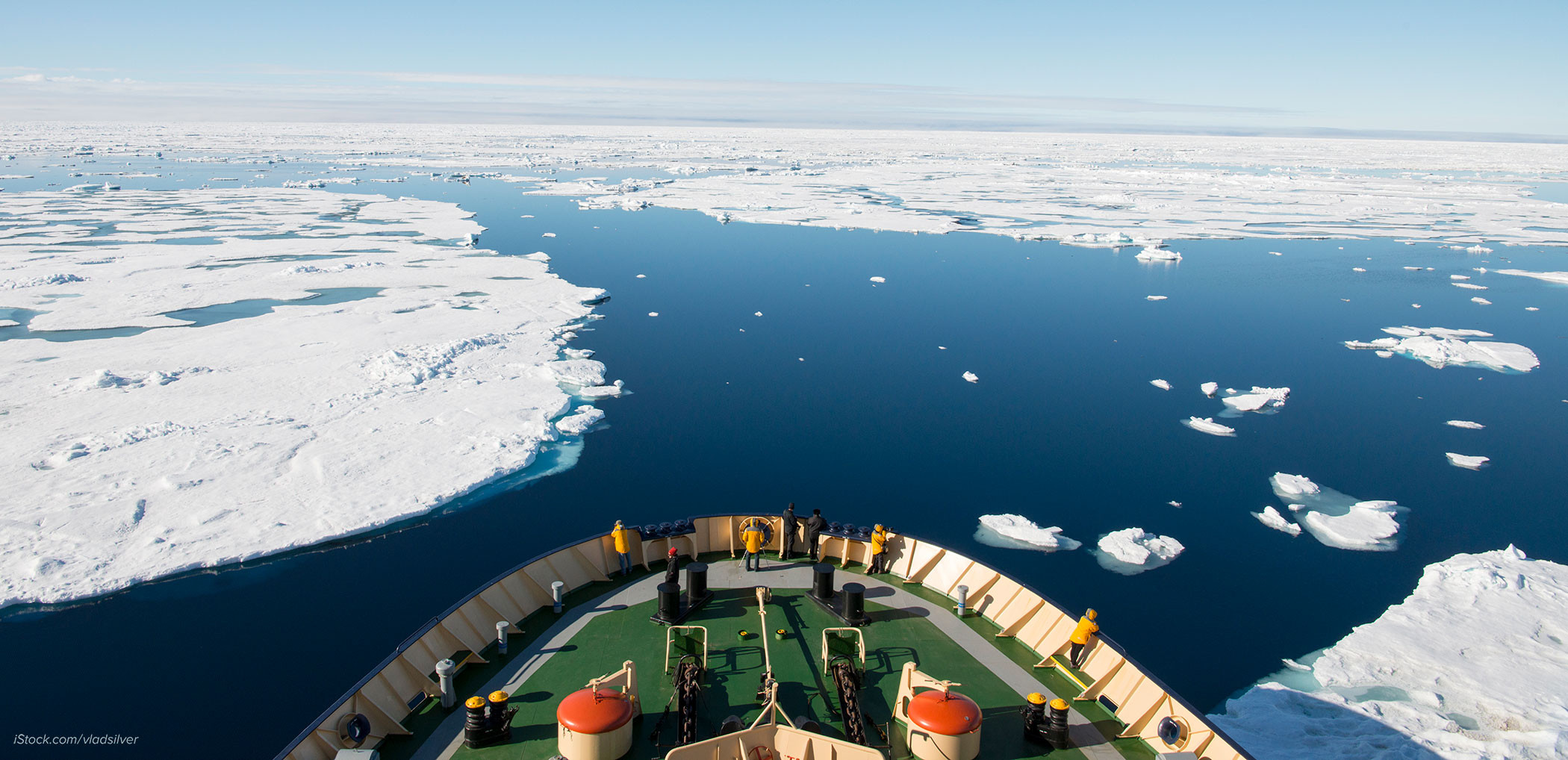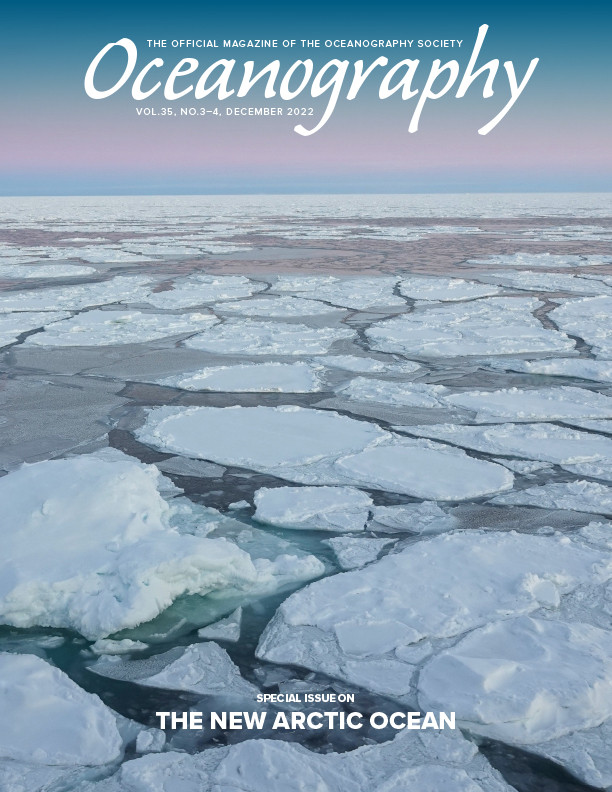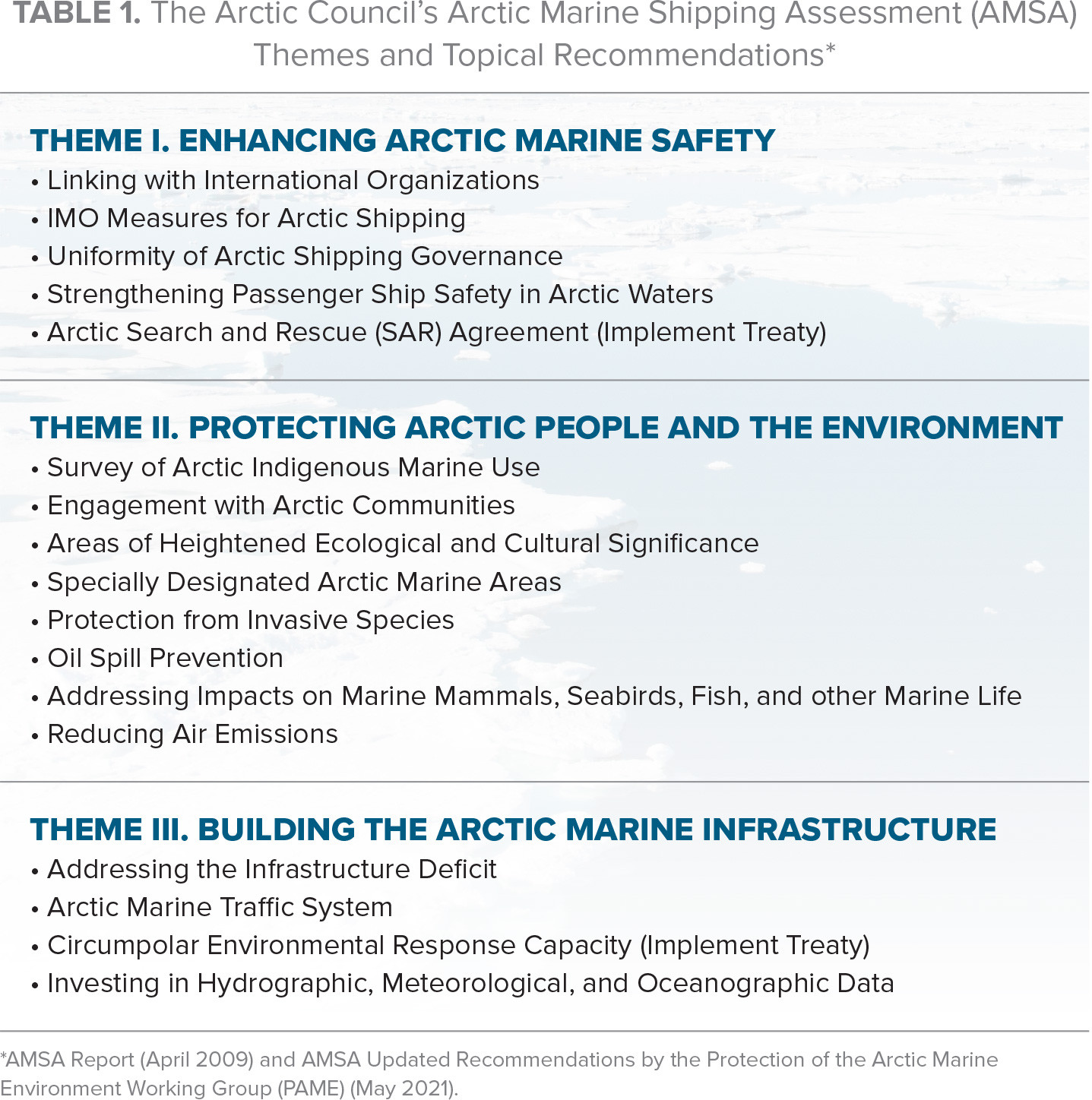Introduction
The Arctic is undergoing many environmental, social, economic, and security changes. Marine access in all seasons is increasing due to the profound retreat of Arctic sea ice driven by anthropogenic climate change, and potentially longer seasons of marine navigation are emerging (Figure 1). Recognizing new and increasing Arctic marine traffic during the past three decades, the eight Arctic states (Canada, Denmark [Greenland], Finland, Iceland, Norway, Sweden, the Russian Federation, and the United States) and international organizations have been proactive in addressing the many challenges and requirements for improved Arctic marine safety and marine environmental protection. Assessments by the Arctic Council (on climate change, shipping, human development, oil and gas, and biodiversity), a new mandatory code of rules and regulations for ships sailing in polar waters (the “Polar Code”; Box 1; IMO, 2017), and key Arctic state treaties have all contributed to significant advances in protection of the Arctic and broad cooperation in the region (see the first three “Agreement” listings among the references for Cooperation on SAR, 2011; Cooperation on Oil Pollution, 2013; and Scientific Cooperation, 2017). However, much more is required: continued implementation of existing measures, more ocean and climate research, development of new and more integrated policy approaches, and expanded infrastructure investment.
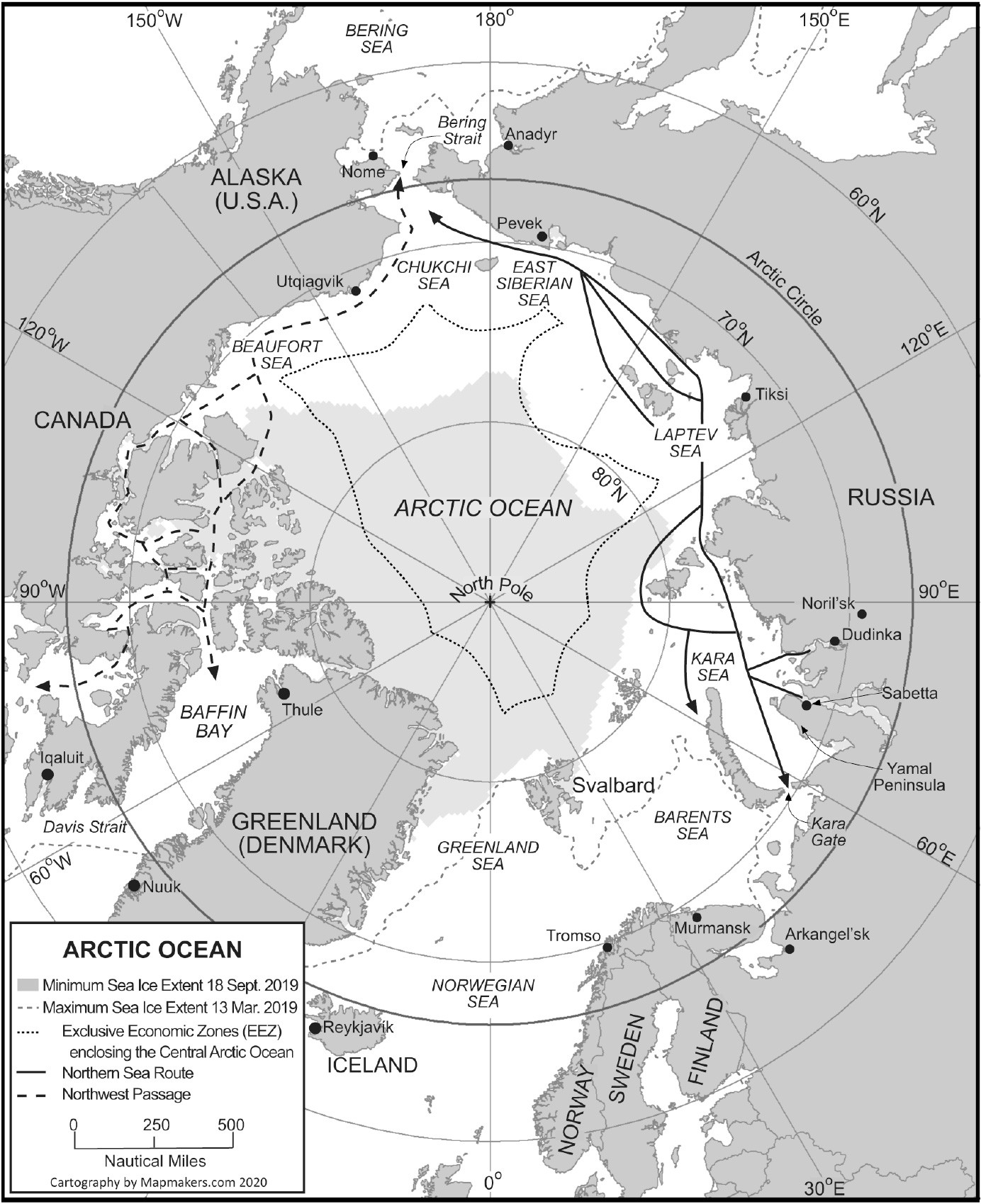
FIGURE 1. The dotted line on this map indicates the outer limits of the Exclusive Economic Zones of the five Arctic Ocean coastal states and defines the area of the high seas or the Central Arctic Ocean. Marine distances here can be long—more than 2,000 nautical miles from Bering Strait through the North Pole and out to Fram Strait between Greenland and Svalbard, and nearly 3,000 nautical miles along the Russian maritime Arctic and the Northeast Passage (the Northern Sea Route does not include the Barents Sea) from Pacific to Atlantic Oceans. > High res figure
|
The Arctic Council’s Arctic Marine Shipping Assessment (AMSA), conducted by the Council’s Protection of the Arctic Marine Environment Working Group, set the tone for Arctic Ocean protection when it was released in April 2009 (Arctic Council, 2009). It was the first comprehensive and integrated review focused on protection of Arctic people and the marine environment in an era of increasing use of the Arctic Ocean. Approved by the Council’s eight foreign ministers, AMSA remains a baseline assessment of Arctic marine activity and a historic snapshot of Arctic marine use early in the twenty-first century. It offers a strategic guide for a host of maritime states, Indigenous groups, marine operators, and a multitude of stakeholders and actors. Most importantly, taken together, AMSA’s recommendations represent a policy framework for the Arctic states.
This paper identifies 12 key strategic goals or pathways forward for using policy measures to protect the future Arctic Ocean. These strategic goals are interrelated and are consistent with AMSA’s three, over-arching themes: Enhancing Marine Safety, Protecting Arctic People and the Environment, and Building the Arctic Marine Infrastructure (Arctic Council, 2009). Table 1 provides AMSA’s three main themes and 17 topical recommendations. Only by using holistic, integrated approaches can effective progress be made in advancing Arctic marine safety and marine environmental protection. Each of these strategic goals will require broad cooperation among the eight Arctic states and within such organizations as the International Maritime Organization (IMO), the International Hydrographic Organization (IHO), the World Meteorological Organization (WMO), and the International Whaling Commission (IWC).
Strategic Goal 1: IMO Polar Code Implementation and Enforcement
Expanding and enhancing the implementation and enforcement of the IMO Polar Code present the Arctic and flag states with many practical challenges for all polar capable ships. For the many flag states involved (most outside the Arctic), the ship classification societies are at the forefront of providing expert technical guidance on ship construction and safety equipment components as well as issuance of a Polar Certificate and a Polar Water Operational Manual under the Polar Code (IMO, 2017). The societies continue to work closely with the flag states in order to provide significant uniformity in how the Polar Code is implemented. For the Arctic states, development and negotiation of an Arctic Port State Control Agreement would be a practical way to enhance effective and harmonized enforcement of the Polar Code. Such an agreement would surely require improved sharing of Arctic marine traffic information among the partners so that each Arctic state would have advance knowledge of ships sailing north to Arctic waters and along established routes. Likely, the Russian Federation would be the only Arctic state concerned about the release (from state to state) of traffic data in a real-time format. However, prior to Russia’ invasion of Ukraine, Russian maritime experts had been open to discussing port state control as a mechanism for improving enforcement of the Polar Code. Future expanded Arctic marine traffic, especially if fishing vessels might be included under the Code, may require a more tightly managed system, with coordinated port state oversight and control of vessels sailing in and out of the Polar Code Arctic area.
The Polar Code came into force five years ago and is now due for a systematic review and gap analysis in order to identify successes and problems. Although it is unlikely the Arctic states could conduct such a review today, select classification societies along with perhaps a nongovernmental organization could be contracted to perform this important work. Significant data and other information (e.g., on national implementation and enforcement processes) would be required from marine operators and the Arctic states to ensure comprehensive and accurate analyses.
Enforcing the diverse elements of the Polar Code is challenging, but the very nature of its complexity and the roles of many maritime states and organizations in the compliance and enforcement process may dictate its success. The primary responsibility for compliance and enforcement rests with the flag states and in some circumstances falls to the Arctic port states. The ship classification societies are influential in certifying that existing and new ships meet Polar Code rules, and the marine insurance industry has a clear role in ensuring only ships that meet new polar standards regarding construction, safety equipment, and manning. Monitoring and tracking of commercial ships operating in Arctic waters to ensure compliance with broad environmental security requirements, including enforcement of the Polar Code, will take on increasing importance.
Box 1. Guide to the International Maritime Organization Code for Ships Operating in Polar Waters (IMO Polar Code)
The IMO Polar Code is a relatively new governance regime for polar waters that addresses marine safety and environmental protection challenges for ships operating in the remote and sometimes extreme conditions of the Arctic and Southern Oceans. The Polar Code entered into force initially on January 1, 2017, and mariner certificate and training requirements were mandated on July 1, 2018. The elements of the Polar Code are amendments to three existing IMO conventions: the International Convention for the Safety of Life at Sea (SOLAS), the International Convention for the Prevention of Pollution from Ships (MARPOL), and the International Convention on Standards of Training, Certification, and Watchkeeping for Seafarers (STCW).
The Polar Code includes new mandatory requirements for ships operating in polar waters, regarding:
• Ship structural and construction standards for Polar Class ships
• Marine safety and life-saving equipment designed for operation in polar environments
• Training and experience of the ships’ officers and crew
• Environmental rules regarding the discharge of oil, noxious liquids, sewage, and garbage
• A Polar Ship Certificate issued by the flag state administration or an authorized representative such as a ship classification society
• An onboard Polar Water Operational Manual unique to a given ship that includes operational capabilities and imitations
The Polar Code is applicable to all commercial carriers and passenger vessels on international voyages that are 500 gross tons or greater. Fishing vessels, small cargo ships, and yachts are not currently under the Code. The Polar Ship Certificate classifies each ship under the Code into one of three types:
• Category A: Ships designed for operation in polar waters in at least medium first-year ice that may have old ice inclusions;
• Category B: Ships for operations in polar waters in at least thin first-year ice that may have old ice inclusions;
• Category C: Ships designed for operations in open water or in ice conditions less severe than those in Categories A and B.
The third category was necessary because Arctic summer ship traffic now includes many vessels, such as large passenger cruise ships, that have been operating in waters that are generally ice-free. The lack of infrastructure available for emergency response and lack of hydrographic information for modern charts pose significant risks and challenges for these vessels. Thus, they must meet the Polar Code’s higher standards of marine safety equipment and requirements for mariner training and experience.
The Polar Code boundary in the Southern Ocean around Antarctica is 60°S, corresponding to the northern boundary of the Antarctic Treaty. The Polar Code boundary in Arctic waters is more complex: in the Bering Sea, the boundary is set at 60°N as one measure to protect the region’s large fishery, which closely follows the seasonal maximum of winter sea ice extent; in the Atlantic, the boundary adjusts to warmer North Atlantic waters, running south of Greenland and then northeast along the East Greenland coast, north of Iceland, and then intersecting with the Russian coast in the Barents Sea.
The IMO Polar Code should be viewed as a seminal advance in international governance of polar waters. The Code’s coverage is broad, mandating operational equipment; defining ship design and construction requirements; addressing specific criteria for operations, manning, and training; prohibiting discharges of oil and noxious liquids in Arctic waters; and mandating controls on the discharge of sewage and garbage in Arctic waters. However, it is a work in progress, a living regulatory instrument, and only the beginning of a long-term effort to protect the Arctic Ocean and its inhabitants.
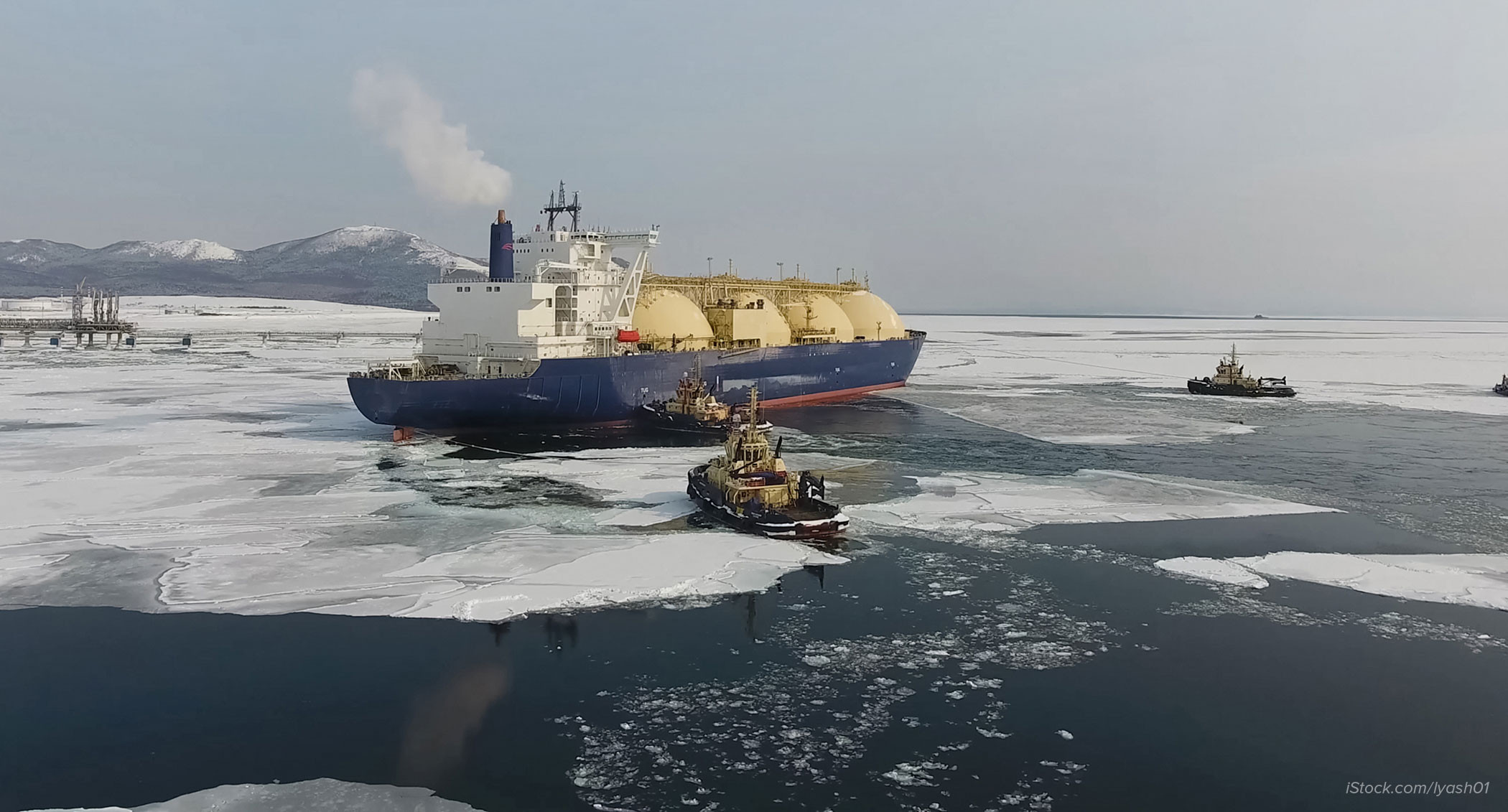
|
Strategic Goal 2: Expansion of Vessels Included Under the IMO Polar Code
The IMO Polar Code was designed initially to address large commercial ships (500 gross tons or more) operating in polar waters, including cargo carriers (such as container ships, gas transports, oil tankers, and bulk carriers) and large passenger vessels, specifically those of the global cruise ship industry that are designated Category C in the Polar Code. Government civilian and naval ships of all types and tonnages (such as icebreakers, hydrographic ships, and survey vessels) are exempt from the Polar Code (IMO, 2017). One of the challenges and limitations of the Code is that it currently does not include fishing vessels, small cargo ships, pleasure craft, and yachts. These vessels are referred to as “non-SOLAS” class, and they generally operate outside the main marine safety and environmental protection regulations mandated for larger vessels.
Past surveys by the Arctic Council and others have indicated that fishing vessels represent the largest population of vessel types using the Arctic Ocean (Arctic Council, 2009). With greater marine access in Arctic coastal waters and in the high seas (the Central Arctic Ocean), and potentially longer fishing seasons in higher latitudes, there is concern for the safety of these smaller vessels and their crews as well as their cumulative discharges of sewage and wastes, air emissions, and plastics from fishing nets and other equipment. The Maritime Safety Committee of the IMO has finalized measures for expanding the Polar Code to include fishing vessels of 24 meters and greater in Arctic waters (WWF, 2022). The Code would also include small cargo vessels and pleasure yachts of 300 gross tons and above. The coastal states with large deep-water fishing fleets will have some concerns due to their historic links to (and control within) the industry and new responsibilities as flag states for implementing and enforcing the Polar Code for a much larger number of vessels. Several of the more challenging tasks for the Arctic coastal states will be effective monitoring and surveillance of these fishing vessels and enforcing the Polar Code along with applicable national fisheries management regulations.
Strategic Goal 3: Arctic Ship Emissions and Heavy Fuel Oil
Although vessel emissions and discharges present a global pollution problem, some are especially critical in the Arctic and require special efforts through both international regulation and voluntary measures. The most common shipping fuel, heavy fuel oil, or HFO, is what remains after almost everything possible has been distilled from crude oil. HFO is very difficult to clean up when spilled, and this is particularly the case in cold water where low temperatures and the presence of ice make the use of traditional oil spill clean-up equipment, such as containment booms, skimmers, and absorbents, difficult if not impossible (Det Norske Veritas, 2011). The risk that a spill of HFO in cold water represents is so extreme that the 2009 AMSA report listed an HFO spill as the single greatest threat to the Arctic marine environment from shipping (Arctic Council, 2009). In addition, the risk of a cold water HFO spill led the IMO to ban its use and carriage in Antarctic waters in 2011 (IMO Annex I Amendment 2011). The IMO has also adopted a ban for HFO in Arctic waters (IMO, PPR7/22/Add. 1: Annex 12) that will enter into force in 2024, but with exemptions for certain vessel types, and waivers that can be granted by an Arctic flag state to ships traveling in Arctic waters under their own flag. The ban will only reduce the amount of HFO used in the Arctic by about 16% until 2029 (Comer et al., 2020), when the ability for the Arctic states to grant waivers expires. The need to transition away from the use of HFO as fuel in Arctic waters more quickly is critical enough that 12 nations signed a resolution that was adopted by the IMO in November 2021 calling for an immediate, voluntary switch to cleaner distillate fuels for vessels traveling in Arctic and near Arctic waters (IMO, Resolution MEPC.342 (77)).
A particularly significant consequence of ships burning HFO is that a common pollutant found in the exhaust is black carbon or soot (ICCT, 2016). A component of PM2.5, black carbon is a result of incomplete combustion of fossil fuels, biofuels, and biomass. For the Arctic, black carbon presents a particularly urgent problem, as it not only warms the atmosphere while in the air but also results in accelerated melting of snow and ice when it settles on these cold, white surfaces. This means that black carbon is a very significant driver of climate change (Bond, 2013), second only to CO2—and ships traveling in or near the Arctic bring black carbon to the very place that is the most sensitive. Black carbon also presents a substantial risk to human health (Janssen, 2012; DeCola et al., 2018), and even remote places may be exposed to this risk if they lie along shipping routes.
Arctic countries, and others with Arctic interests, should pursue an immediate transition away from HFO to cleaner distillate fuels in Arctic waters. This will have the dual benefit of lessening the risk of a devastating oil spill and very significantly reducing emissions of black carbon from ships in the Arctic.
Strategic Goal 4: Marine Protected Areas
Marine protected areas (MPAs), which restrict human activities for the purpose of conservation, not only protect specific areas that have been found to be especially sensitive, important to biological productivity, or vital to the subsistence and/or cultural practices of Indigenous peoples but also help to protect biodiversity. And they provide a place for scientists and the public to observe nature in an undisturbed state. Currently, the United Nations Convention on Biodiversity is leading a process to develop a new Global Biodiversity Framework, with a likely goal of protecting 30% of our planet by 2030, usually referred to as 30×30. This goal seems to be largely supported by the Arctic states, and it provides an excellent opportunity to identify and create new MPAs for sensitive and valuable Arctic marine areas.
Terrestrial protected areas were well represented as of 2019, with over 1,000 divided among the permafrost region in the eight Arctic states. However, MPAs are very underrepresented, with only about 60 that do not include a coastal component Arctic wide (IUCN and UNEP-WCMC, 2019). This highlights the need for more science and assessment of Arctic marine areas to determine those that are important for protection. Working within the Arctic Council’s Protection of the Arctic Marine Environment (PAME) Working Group, a Marine Protected Area Expert Group has focused on assessing the state of important Arctic protected areas and has produced an MPA Network Toolbox (Arctic Council, 2017). Their findings show that while the Arctic states have established several MPAs, there are still many gaps to be filled.
With the extreme pressure on Arctic ecosystems being brought about by climate change, and increasing economic development activities, a harmonized approach to existing MPA management is vital. The development of new MPAs must be oriented toward protecting a diversity of Arctic flora and fauna and the ecosystem services that they provide. In addition, there should be a formalized understanding of Arctic MPAs as “no dumping” zones, which would be an essential step toward protecting these areas from shipping pollution. Finally, the Arctic states should urgently support 30×30, especially in Arctic waters, and proceed with the research, inclusion of Indigenous knowledge (IK), and involvement of Indigenous leaders necessary to identifying and implementing MPAs in the region. A recent US definition of ITEK, or Indigenous Traditional Ecological Knowledge, is applicable: “a body of observations, oral and written knowledge, practices and beliefs that promote sustainability and the responsible stewardship of natural resources through relationships between humans and environmental systems” (White House, 2021).
Strategic Goal 5: Surveys of Indigenous Arctic Marine Use
Organizations such as the Arctic Council have long recognized the need to conduct comprehensive surveys of Indigenous marine use in all sovereign waters of the Arctic coastal states. The objective is to integrate IK with what is often referred to as “Western science” within the national surveys to create a holistic map of Arctic Ocean Indigenous marine use. Such a map would be used to assess the impacts (seasonal and year-round) of regional marine operations and potential trans-boundary shipping routes. This would allow an evaluation of the potential impacts on food and cultural security for Arctic coastal communities. A comprehensive survey of this type was a key recommendation of the 2009 AMSA report, which also called on Arctic states to identify areas of heightened ecological and cultural significance. The most comprehensive effort provided a partial picture of cultural and subsistence use areas in a report published in 2013 by the Arctic Monitoring and Assessment Programme (AMAP) working group, the Conservation of Arctic Flora and Fauna (CAFF) working group, and the Sustainable Development Working Group (SDWG) of the Arctic Council along with the Permanent Participants’ Aleut International Association and the Saami Council (AMAP/CAFF/SDWG, 2013).
The best scenario for a comprehensive survey of this nature is likely an effort to be led by one or more Arctic Indigenous organizations, such as those within the Arctic Council Permanent Participants. Both the Inuit Circumpolar Council (ICC) and the Saami Council have constituencies that span multiple Arctic states and have extensive experience working with a variety of international institutions; for example, the ICC became the first Indigenous organization with Consultative Status at the IMO in November of 2021 (ICC, 2021). Finally, it will be crucial that the Arctic states provide the needed resources for a truly comprehensive survey of areas of importance for subsistence use and cultural significance.
Strategic Goal 6: Ecosystems-Based Management and Indigenous Knowledge
Arctic Indigenous peoples have lived and depended on Arctic lands and waters for many millennia, developing a special knowledge of place that is passed from generation to generation. Indigenous knowledge has provided valuable insights into a variety of Arctic topics such as the health and status of ecosystems, changes in weather patterns, variability in species migration, and many more. IK and Western science complement each other and should be considered equally in Arctic research. Accomplishing this may require extra time on a project to ensure the participation of all stakeholders.
The Arctic Council definition of ecosystem-based management (EBM) describes it as “the comprehensive, integrated management of human activities based on the best available scientific and traditional knowledge about the ecosystem and its dynamics, in order to identify and take action on influences that are critical to the health of ecosystems, thereby achieving sustainable use of ecosystem goods and services and maintenance of ecosystem integrity” (Arctic Council, 2013). Put more simply, it is a system for managing human activities that considers the entire ecosystem, including humans, in decision-making. EBM doesn’t focus on deliverables, such as maximizing productivity of a few species, but instead focuses on long-term sustainability as the goal. Most marine area management systems make use of at least some of the principles of EBM, such as using the best available science and IK to assess the state of the ecosystem, identifying current and possible future stressors, enabling full participation by all stakeholders, assessing potential economic and ecological trade-offs, setting goals with long term sustainability in mind, and evaluating management measures to assess their effectiveness on a regular basis. However, these efforts often fall short due to a lack of resources and/or commitment.
In the Arctic there is an opportunity to “do it right” by combining IK and Western science to gather much needed data to answer questions about the region, and then using the principles of EBM to analyze, prioritize, and manage human activities to ensure sustainability. “Doing it right” also means that Arctic research and policy must make it happen with robust cross-border cooperation among all stakeholders, sufficient resources, and striving to collaborate fully with Indigenous peoples to holistically include IK at all levels of the EBM process.
Strategic Goal 7: Integrated Arctic Observing Network
Despite a long and notable history of Arctic exploration and observations, the fact remains that records for the region are very incomplete, with major gaps in nearly all disciplines. The reasons for this are obvious: the region is remote, and the Arctic environment is challenging for both people and equipment. Thus, exploration and observations are more resource intensive than in other regions of the planet. Consistent, long-term observations are especially challenging; consequently, significant time series are lacking. By its very nature, the Arctic is an area of international interest, not only for the eight countries that border the Arctic but also for a host of other nations that recognize the important relationship of the Arctic to the entire planet. This makes the Arctic a natural place for an integrated observing network that utilizes the resources of many contributors, both public and private.
Efforts along these lines are underway, as exemplified by Danielson et al. (2022, in this issue), Lee et al. (2022, in this issue), and others. Development and maintenance of a robust Integrated Arctic Observing Network (IAON) as a fundamental part of Arctic infrastructure will be essential to understanding the profound impacts of climate change and increasing human activity in the Arctic. In addition, a well-functioning IAON will greatly enhance maritime safety and environmental protection by supporting governance regimes such as the IMO Polar Code and by providing critical, real-time information to Arctic marine operations. An IAON will also be crucial to the research needs of the Central Arctic Ocean Fishing Agreement (discussed below).
It should be noted that there are institutions well poised to mobilize a new IAON, such as the International Arctic Science Committee (IASC), a nongovernmental organization established to encourage, facilitate, and promote cooperation in Arctic research, and Sustaining Arctic Observing Networks (SAON; Chythlook et al., 2022, in this issue), a joint activity of IASC and the Arctic Council organized to enhance Arctic-wide observing activities. It is important that the Arctic states in partnership with Indigenous organizations and other stakeholders work to develop enhanced observing networks by providing the necessary resources and ensuring that data gathered is made freely available to users in as near-real time as possible. It is also crucial that recommendations to policymakers realized from integrated observing be as robust and specific as possible to provide enhanced decision-making.
Strategic Goal 8: Central Arctic Ocean Fisheries Agreement
The Central Arctic Ocean Fisheries Agreement is a groundbreaking example of the precautionary principle put effectively into practice. Signatories are Canada, China, Denmark (in respect to Greenland and the Faroe Islands), the European Union, Iceland, Japan, Norway, the Russian Federation, the Republic of Korea, and the United States (Agreement to Prevent Unregulated High Seas Fisheries in the Central Arctic Ocean, 2021). The agreement, which entered into force on June 25, 2021, is designed to prevent unregulated fishing in the area of the Arctic Ocean beyond national jurisdiction and to promote joint research and monitoring in this remote region. Representing both challenge and opportunity, the agreement commits the signatories to disallowing commercial fishing in the area for at least 16 years, and to gathering much needed information about the Central Arctic Ocean ecosystem during that time. This is a marked departure from the way that commercial fishing typically happens, where fishing interests exploit new fish stocks, and then seek to determine how these fish fit into the ecosystem and what level of fishing is required to attain sustainability, often after the stocks have crashed, or some other event points to a problem. Unfortunately, the results of this approach are often very negative, and there are areas where, even after decades, fish stocks have not recovered from overfishing.
The CAO agreement provides the opportunity to gather information about the region by prioritizing both Western science and IK, and then to manage human activity in the region according to the principles of ecosystem-based management. The agreement also necessitates cross-border cooperation and can serve as a model for other regions that may benefit from inclusive research and management across national borders. The Arctic states, Arctic Indigenous peoples, and other stakeholders with an interest in promoting sustainability of the region should move forward with data gathering to promote co-production of knowledge and development of an inclusive and effective management plan with all possible speed.
Strategic Goal 9: Arctic Treaties and Marine Infrastructure
It can be argued that the most significant issue facing future Arctic Ocean use is the lack of marine infrastructure for providing emergency response, monitoring change, and facilitating safe navigation (including from enhanced bathymetry and hydrography). The only exceptions are modern infrastructure nodes in northwest Russia on the Kola Peninsula, in northern Norway, and on the coast of Iceland (Arctic Council, 2009). This Arctic marine infrastructure deficit hinders the full implementation and development of four recent Arctic treaties regarding search and rescue, oil spill preparedness and response, scientific cooperation, and the Central Arctic Ocean Fisheries Agreement. The lack of an Arctic state-driven investment strategy for marine infrastructure, even for an Arctic observing network that would monitor climate change, remains a major stumbling block to addressing this critical, large-scale challenge. Establishment of an observing network could also provide key, real-time observations to support safe and efficient Arctic marine operations, assist in the enforcement of the IMO Polar Code, and support the implementation of the four active Arctic treaties. Thus, this single and major infrastructure improvement would fill multiple, critical roles.
However, lack of commitment for shared funding and physical assets among maritime states, combined with diminished cooperation among the eight Arctic states and a pause within the Arctic Council, hinders near-term agreement on urgent needs. At the same time, the IMO Polar Code demands more attention be given to coastal infrastructure based on mandatory regulations designed to prevent the discharges of sewage and garbage; the practical issue is that few facilities exist around the Arctic Ocean to support the new, now binding rules and regulations. A longer-term strategic perspective is necessary. The role of public-private-partnerships must be fully explored where the maritime industry is a key investor and stakeholder in developing Arctic marine infrastructure. Potential areas of infrastructure cooperation between governments (national and regional) and private industry include: communications systems; ship traffic monitoring and surveillance; port development; regional response and recovery equipment; remote, coastal discharge facilities; commercial icebreaker support agreements; weather and sea ice information systems; marine salvage support; and future marine traffic routing systems. Marine industry experts must be full partners in all gap analyses that review Arctic preparedness and response operations conducted by the Arctic states, international and Indigenous organizations, and nongovernmental organizations.
Strategic Goal 10: Roles of the Marine Insurance Industry and Ship Classification Societies
The roles of the marine insurance industry and ship classification societies are vital to the continued implementation and long-term success of the IMO Polar Code. As a broad policy framework, the Code has provided both of these marine industries with a set of uniform, nondiscriminatory, and international rules and regulations. Both are key to evaluating the future risks of polar marine operations and to the creation of a truly uniform Arctic maritime governance regime, a goal identified in AMSA (Arctic Council, 2009). The ship classification societies individually and together in their representative body, the International Association of Classification Societies (IASC), have taken the lead to further develop the elements of the Polar Ship Certificate and the Polar Water Operational Manual; they are engaged in refining the Code’s technical details, particularly construction standards, and further development of the seven Polar ship classes (PC1, the highest, to PC7, the lowest). The flag state maritime authorities and ship classification societies must continue to work closely together in establishing the certificate and the manual. The marine insurers and ship classification experts can also have key roles in the advancement of the Polar Code as a long-term framework for uniformity and harmonization of existing national Arctic shipping regimes. Finally, the marine insurance firms and classification societies are integral to the long-term enforcement of the Polar Code through their close relationships with the flag state maritime administrations and the marine operators.
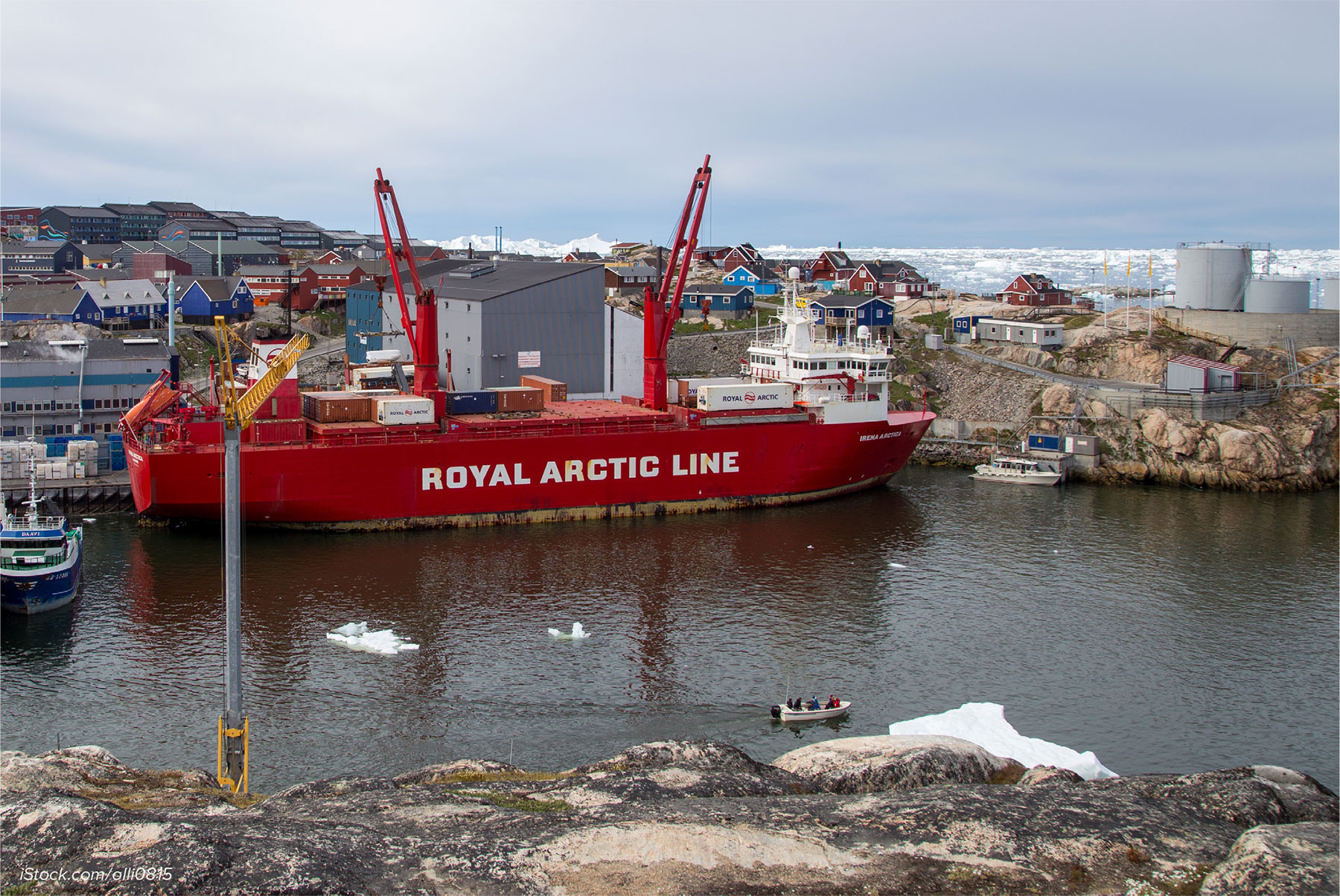
|
Strategic Goal 11: Roles of the International Whaling Commission
The International Whaling Commission (IWC) has important roles to play in the protection of the Arctic marine environment and in creating measures to reduce the risks to Arctic marine mammals. The IWC must also consider the challenges and complex issues of Arctic subsistence hunting and whaling. Mitigation measures for threats to marine mammals include noise reduction, speed restrictions (to reduce ship strikes), and marine traffic separation schemes or routes (IWC, 2014). The impacts of sound/noise on marine mammals have gained the attention of the IMO, which is reviewing the guidelines on the reduction of underwater noise. The IMO and IWC should develop close cooperation on addressing noise impacts in the ocean, perhaps in partnership with the Inuit Circumpolar Council (to gain Indigenous perspectives) as an IMO observer. Developing effective measures for mitigating the impacts of noise in all coastal waters and high seas, especially those of the Arctic Ocean, is extremely complex and requires the participation of many stakeholders and actors, including the Arctic states and their maritime agencies, the IWC, the IMO and other intergovernmental organizations, marine operators, subsistence communities and their representatives, ship classification societies, and nongovernmental organizations. Data collection and sharing, and assessment of threats, are key issues. Effective monitoring and compliance measures are equally essential for implementation and long-term enforcement. The IMO Correspondence Group that is currently reviewing the existing vessel noise reduction guidelines must consider ways to make the current guidance more effective, examine potential new technological and operational measures, and determine if there is a role for mandatory measures in additional to those that are voluntary.
Strategic Goal 12: Communications and Enhanced Arctic Waterway Information
Improving the quality and relevance of information communicated to ships operating in the Arctic Ocean is a critical need. Achieving this will require having reliable communications systems that provide near-real-time and high-quality weather and sea ice information, including direct satellite imagery and environmental data as well as analyses sent as products by national weather and ice centers. Greatly improved regional and local communications between transiting ships and Arctic coastal communities are also required. Today’s electronic chart displays and information systems, coupled with digital Global Positioning Systems (GPSs), have revolutionized ship navigation. Safe navigation in the Arctic Ocean has been greatly enhanced by precise, real-time positioning integrated with key environmental and navigation information.
The next step in improving information transmitted to ship pilothouses is development of an electronic “coast pilot” that includes detailed information that is perhaps unique to Arctic marine operations. Information to be provided in a pilothouse display would include areas of subsistence hunting (for whales, seals, walruses, fish, and birds) as provided by Indigenous surveys, voluntary ship routing measures, marine mammal seasonal migration patterns, electronic or virtual aids to navigation, high-resolution bathymetric (charting) information for coastal shallow-water operations, national and international boundaries, places of refuge for ships in distress or in need of assistance, and Arctic marine areas of heightened and ecological and cultural significance. This concept, developed by the Marine Exchange of Alaska, a public-private partnership, uses an advanced vessel-tracking system to enhance marine safety, protect the marine environment, and prevent maritime disasters (https://www.mxak.org/). Information on local subsistence hunting and whaling could be communicated electronically in near-real time. Testing a prototype electronic coast pilot for Arctic waters is feasible and could be funded by a public-private partnership (with marine operators), an Arctic state coast guard, or a maritime administration. Better and faster communication of critical maritime information between ship operators and other users of Arctic coastal waters is a marine safety imperative.
Concluding Comments and Recommendations
Complexity and uncertainty will be constants in future Arctic marine operations and shipping. The only tangible certainty in the twenty-first century is continued warming at the top of the world and the resulting glacial melt and striking changes in sea ice thickness, extent, and character. Multi-year sea ice will disappear, perhaps before mid-century, and seasonal ice will be the norm throughout the Arctic Ocean. This continued retreat of sea ice will provide further marine access and likely stimulate increased traffic. However, new marine traffic will be constrained by the economics of the global shipping enterprise, Arctic natural resource developments (and their linkages to world commodity prices and markets), new technologies (such as new fuels for powering ships), and surely global geopolitics.
Despite many challenges, there are clear pathways ahead, and action can be taken on specific recommendations. Table 2 lists 10 equally important, high priority recommendations for advancing protection of the Arctic Ocean. Each can be considered a potentially notable, effective advance, and all are considered executable. The breadth of the recommendations highlights the complexity of the approaches and measures that can and should be taken to the protect Arctic residents and the marine environment.
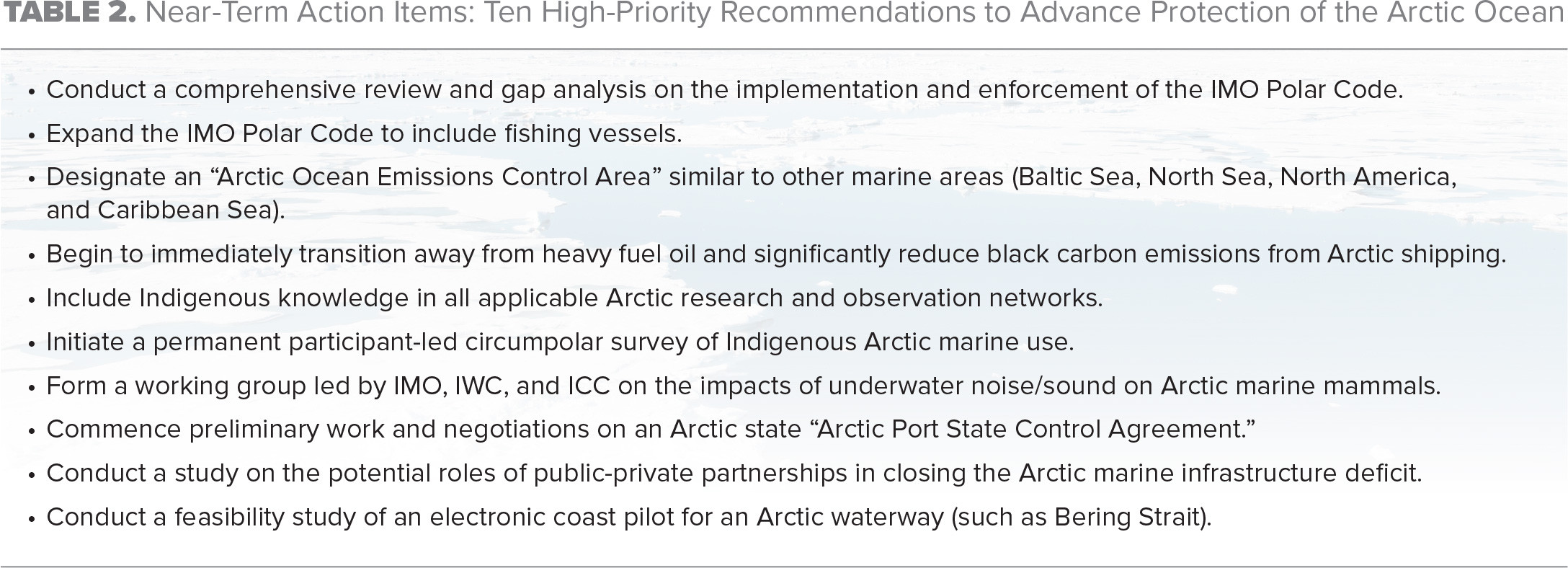
|
Russia’s invasion of Ukraine in February 2022 has caused many unforeseen and unintended consequences for the Arctic. The work of the Arctic Council has been paused, and scientific cooperation has been highly disrupted. The pace and overall economics of Arctic development, particularly in the Russian sector, have been severely affected, with sanctions, the termination of substantial international investments, and the disruption of components of global shipping. However, critical work on protecting the Arctic Ocean that will continue includes development of ongoing rules and regulations at the IMO on air emissions, use of heavy fuel oil, and the addition of smaller vessels under the IMO Polar Code. Beyond the purview and engagement of the Arctic Council, other international organizations with Arctic state delegations in the lead will take up the mantle of protecting the Arctic Ocean. The marine insurance industry and ship classification societies are advancing their work related to high-latitude marine operations and modern ship safety requirements. Further implementation of the four recent Arctic treaties will be more problematic in the short term, but long-term investments and cooperation (among the Arctic states, non-Arctic states, and industry) are plausible with a focus on the practical aspects of marine safety and environmental protection.
Protecting Arctic human populations and the marine environment remains a long-term, cooperative venture among the maritime states, Arctic Indigenous peoples, and the global maritime industry.
ACKNOWLEDGMENT
LWB is supported by National Science Foundation grant #2022571-NNA Track 1, Collaborative Research: Navigating Convergent Pressures on Arctic Development to the University of Alaska Fairbanks.
